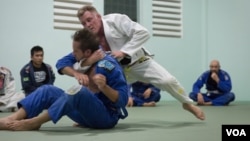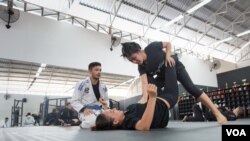One of the world’s best-known martial arts, jiu jitsu—which was first brought to Cambodia about 20 years ago—is gaining more popularity in the country, especially among expatriates.
Jiu jitsu, derived from several Japanese martial arts, was adapted and transformed by Brazilians in the early 1900s. It quickly become a popular self-defense and combat sport in its own right, but also forms a core part of the fast-growing sports mixed martial arts (MMA) and K-1 kickboxing.
Jiu jitsu is thought to have first been brought to Cambodia by American legal scholar and Cambodia researcher Peter Maguire when he was a journalist based in 1990s Phnom Penh.
A practitioner of the Gracie school of jiu jitsu, Maguire trained French expats and diplomats of other nations. One of his pupils was Cambodia-based French linguist Sylvain Vogel, who was already an accomplished martial artist and Thai boxer, according to Maguire.
“Cambodian martial arts are mostly striking arts like kickboxing, karate, and kung fu,” Maguire wrote in an email to VOA Khmer. “Gracie jiu jitsu is a relatively young martial art, given that it has only been in Southeast Asia for at little over 20 years, it has spread very quickly.”
After Maguire published his book “Facing Death in Cambodia” in 2005, his trips to the country became less frequent. Cambodian jiu jitsu languished until 2014 when brown-belt Jens Petersen moved to Phnom Penh and began teaching at the K1 Fitness and Fight Factory. Growing interest in MMA fighting in Cambodia has also contributed to jiu jitsu’s newfound popularity.
Two senior instructors are now training Brazilian jiu jitsu in Cambodia. The classes grew quickly and today there are more than 20 active members, up from less than 10 in early 2014, according to Vivaddhana Khaou, one of the instructors.
A 27-year-old French-Cambodian entrepreneur, Vivaddhana is currently teaching at two gyms and also volunteers at a nongovernmental organization to teach jiu jitsu to young Cambodians.
Vivaddhana Khaou, who was trained in the martial art in Japan and returned to Cambodia in 2014, told VOA Khmer that jiu jitsu was being practiced more and more in Cambodia, especially in the expat community. He said the organization BJJ Cambodia was now building a strong Brazilian jiu jitsu community. He hopes that, eventually, a federation will be established so that Cambodians can take part in competitive international matches.
“Right now, we are trying to do…what Peter did, trying to reconnect with his old students and connecting them to us, so we expand our network,” said Vivaddhana. “By reconnecting with his old students, we’ll be able to bring back the old community and merge with the new community for jiu jitsu today, which is, for me, very exciting. And it is more exciting for me to make jiu jitsu accessible for everybody.”
However, he said, a lack of training locations, and the fees for classes are still issues for BJJ Cambodia to allow Cambodians to access training.
Vath Chamroeun, secretary general at the National Olympic Committee of Cambodia, who trained in jiu jitsu in 1990s, said the martial art’s emergence was slow in Cambodia because it has had to compete with other popular to Japanese-originated forms like judo. There were also no jiu jitsu competitions at international events until few years ago, when it was introduced at the Asian Games in Thailand, he added.
He said the National Olympic Committee was pleased to see jiu jitsu growing in the country. “They have the full right to a federation, it is very important that the specialists in this sport are gathering together and form it. The Olympic committee is happy and here to help,” he told VOA Khmer.
Vivaddhana and another head instructor based in Phnom Penh are already holding training courses in at least two gyms in the city. In addition to daily training, BJJ Cambodia established a workshop on Monday last week and invited Chris Haueter, a world-renowned coach of Brazilian jiu jitsu, to train with a team in Phnom Penh.
Haueter said he was impressed to see practical jiu jitsu training taking hold in a dynamic society like Cambodia. The sport was an “intimate and honest martial art” that could bring together expats and Cambodians, he said.
“I am really happy and excited for what Vivaddhana has done. I hope he can get a program going for the locals, as most of the club is comprised of expats,” Haueter wrote in an email. “I hope so, but my stay was so short. Peter was here for quite a while, and very passionate about Jiu Jitsu and his journalism. I think Vi can continue this. Clearly he has the passion! And he's native Cambodian.”
Along with other civil society efforts, Haueter said, jiu jitsu could help to heal the still-fresh wounds of more than two decades of civil war in Cambodia, which came to an end in the 1990s.
“I could sense the scars and remaining pain from the Civil War, especially with the older generation who first-hand witnessed. People of Cambodia are resilient there's a humbleness to them, maybe from the war,” Haueter said. “I believe the Jiu Jitsu can be a piece of the healing.”
Likewise, Vivaddhana—who believes jiu jitsu is a type of “gentle art” that builds trust among people—said the sport could play a part by helping to build a society that is stronger, both physically and mentally.
“I think jiu jitsu really does something to people…. It allows them to come to understanding,” Vivaddhana said. “When you’re training jiu jitsu, oftentimes, you are not going to think about all the problems in your life, it allows you to live in the moment, it allows you to start thinking how to solve the problems in front of you right now.”
“It allows you to put whatever problems in your past and the problems you have right now and put them into perspective and solve it,” he added.
Maguire agreed that jiu jitsu can change an individual’s perception and intellectual processes, and prepare the practitioner for life’s challenges.
“Despair, low self-esteem, and a lack of motivation are today’s real enemies and they can all be managed and defeated by the Jiu Jitsu lifestyle,” he wrote. “Jiu Jitsu teaches you how to survive on the mat and thrive in the real world. On a more practical level, anything that gets Cambodians away from their phone and computers is a good thing.”





